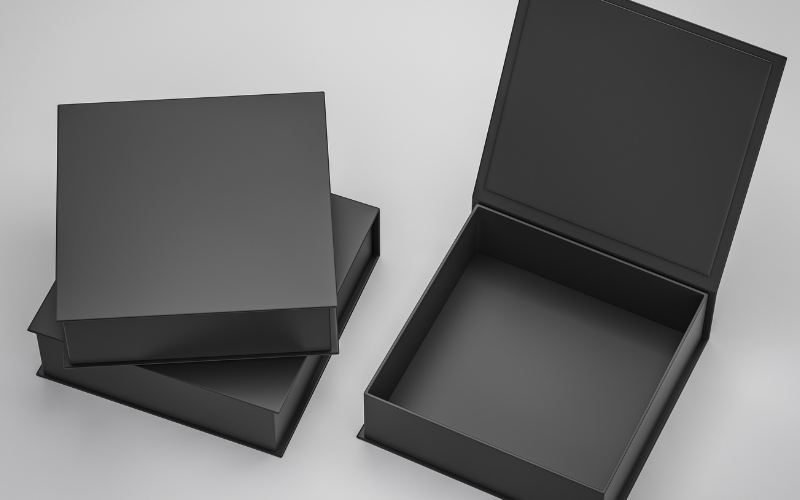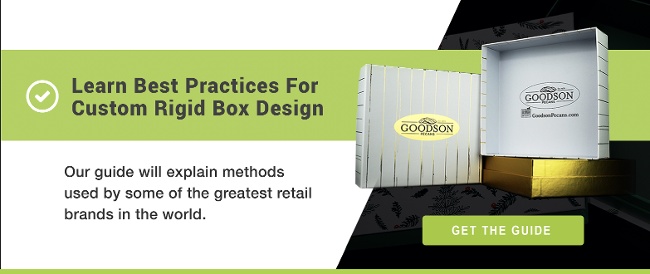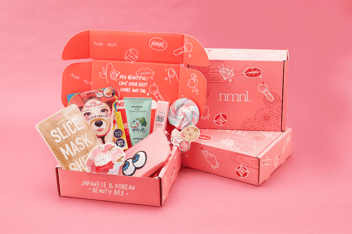What Are Custom Rigid Boxes and the Benefits of Using Them?
What Are Custom Rigid Boxes?
As their name suggests, rigid boxes are a form of packaging characterized by a robust and sturdy structure. Unlike foldable cartons or flexible bags, these boxes retain their shape and do not collapse or fold flat.
Rigid boxes are typically crafted from heavyweight paperboard, which is often more than three times the thickness of a standard folding carton. This density gives rigid boxes their characteristic strength. The outer layer of rigid boxes is often decorative or branded paper, fabric, or leather, which lends them a premium appearance.
You might already be familiar with some rigid boxes without realizing it; they are commonly used for luxury goods, electronics, and special edition products, thanks to their upscale look and feel.
Different from other packaging options
When diving into the vast world of packaging, it’s clear not all packaging solutions are created equal. With their unique attributes, custom rigid boxes stand out from the crowd in various ways:
1. Structural Solidity: Unlike flexible pouches or foldable cartons, which might bend or crease, rigid boxes retain their shape, ensuring products always have a consistent, high-quality presentation.
2. Enhanced Protection: The robustness of rigid boxes provides added security, making them ideal for fragile or luxury items requiring an extra safety layer.
3. Aesthetic Appeal: With the potential for high-quality prints, textures, or finishes, rigid boxes often become more than just containers—they're a part of the overall product experience.
4. Branding Potential: Many packaging solutions focus strictly on function and overlook branding opportunities. Custom rigid boxes, however, can seamlessly integrate and elevate brand identity.
By understanding these distinguishing factors, businesses can decide which packaging solution aligns best with their products and branding goals.
Types of Custom Rigid Boxes
Custom rigid boxes are a premium choice that marries protection with elegance and redefines the consumer unboxing experience. These boxes aren't just about containing a product—they also enhance its presentation. But what exactly are the form factors for custom rigid boxes, and what variations are available? Some common options include:
- Two-piece Boxes: Often likened to shoeboxes, two-piece boxes have a base and a separate lid. They're simple yet classic, making them suitable for various products, including electronics and cosmetics.
- Hinged Lid Boxes: These boxes have a lid attached to the box body, creating a flap-like opening. They're popular for products like luxury chocolates or high-end accessories.
- Sliding/Drawer Boxes: As the name suggests, these boxes feature a sliding mechanism wherein the product drawer pulls out from a sleeve. They're commonly used for tech gadgets or jewelry, adding an element of surprise to the unboxing experience.
- Collapsible Rigid Boxes: Engineered for efficiency, these boxes can be folded flat when not in use, which can help save space. They can be easily assembled into a rigid form, making them perfect for brands that need sturdiness and storage flexibility.
- Magnetic Closure Boxes: Fusing security with sophistication, these boxes come equipped with magnets on the flap, ensuring a tight, discreet closure. Because the magnets add a touch of luxury to the overall feel, they're often chosen for premium product kits or gift sets.
By understanding the different types of rigid boxes, businesses can tailor their packaging strategy to suit both the product and audience, ensuring each box isn't just a container but an integral part of the consumer experience.
Benefits of Using Custom Rigid Boxes
In today's competitive market, packaging does more than just enclose a product—it communicates brand values, tells a story, and elevates the entire user experience. Custom rigid boxes are a definite front-runner, offering a harmonious blend of function and form. Beyond their undeniable aesthetic appeal, these boxes boast many advantages by catering to businesses and end consumers alike. So, what makes them a preferred choice for modern packaging?
Here are some of the benefits of using custom rigid boxes:
- Durability and Protection: Crafted from heavyweight paperboard, rigid boxes are robust, providing excellent protection against external pressures or damages. Products enjoy a safe sanctuary, reducing potential returns or complaints.
- Premium Unboxing Experience: Rigid boxes' sheer elegance and high quality enhance the unboxing journey. For consumers, it's not just about the product but the memorable experience that comes with it.
- Eco-friendly Options: Many rigid boxes are designed with sustainability in mind. They can be crafted from recycled materials and are often reusable, aligning with the growing global emphasis on eco-conscious practices.
- Versatile Customization: The potential to tailor rigid boxes to specific brand aesthetics is vast. Businesses can craft a packaging solution that resonates with their brand ethos, from unique shapes, sizes, and prints to innovative closures and embellishments.
- Increased Perceived Value: A quality package often translates to a quality product in the consumer's mind. Rigid boxes can elevate the perceived value of the enclosed product, potentially allowing for higher price points.
- Efficiency in Storage & Shipping: Rigid boxes' uniform and sturdy structure makes them easily stackable and optimizes storage space. This efficiency can lead to cost savings in warehousing and reduced damages during shipping.
Incorporating custom rigid boxes into a brand's packaging strategy isn't just about aesthetics; it's about leveraging their many benefits to enhance product value, consumer perception, and overall brand identity.
Industries That Benefit from Custom Rigid Boxes
Rigid containers are not solely reserved for high-end brands; many industries harness their benefits to elevate products, make memorable impressions, and underscore brand commitment to quality. So, which industries can benefit most from these premium boxes?
Although not exhaustive, some examples of industries that can benefit from custom rigid boxes are:
- Luxury Goods: Brands dealing in high-end watches, designer accessories, or limited edition items often choose rigid boxes to mirror the exclusivity and luxury of their products. The box becomes an extension of the product's opulence.
- Tech Gadgets: Whether smartphones, smartwatches, or headphones, the tech industry values packaging that promises protection and exudes sophistication. Custom rigid boxes deliver on both fronts, making them a popular choice.
- Jewelry: Delicate and valuable jewelry items require packaging that ensures their safety while echoing their elegance. Rigid boxes, often with plush inserts, fit the bill perfectly.
- Cosmetics & Skincare: The beauty industry thrives on aesthetics and brand presentation. Rigid boxes, customizable to various shapes and designs, enhance the allure of cosmetic and skin care products and make them stand out on crowded shelves.
- Gourmet Food & Chocolates: Packaging is crucial to communicating the quality and taste of artisanal chocolates or gourmet food items. Rigid boxes protect these delicacies and elevate the overall gifting and consumption experience.
- Board Games & Collectibles: Products meant for collection or extensive handling, like board games or collector's edition items, benefit from the durability and sturdiness of rigid boxes, ensuring longevity and pristine condition.
- Publishing & Stationery: Premium editions of books, planners, or stationery sets packaged in custom rigid boxes underscore their unique nature to make them desirable collectibles or gifts.
By aligning products with the unmatched quality of custom rigid boxes, these industries ensure protection while crafting an unboxing narrative that resonates with their target audiences and creates lasting impressions.
Related Content: Rigid Packaging vs. Flexible Packaging: Which to Choose?
Cost Considerations
When exploring custom rigid boxes, an immediate factor brands consider is cost. Admittedly, custom rigid boxes often come with a higher upfront price than standard or flexible packaging options.
This increased initial investment can be attributed to the premium materials, intricate manufacturing processes, and superior customization options that rigid boxes offer.
However, viewing this upfront cost through a broader lens is important. Over the long term, these boxes can provide a return on investment that might need to be clarified right away. For instance, the durability of rigid boxes means fewer damaged goods during transit, translating to reduced returns and replacements over time.
The premium feel and unboxing experience can significantly elevate a product's perceived value, allowing brands to command higher price points. Standout packaging can also enhance brand recall and loyalty, leading to repeat purchases and word-of-mouth referrals.
When one factors in these long-term benefits, it’s easier to justify the initial investment in custom rigid boxes, ultimately positioning them as a valuable asset in a brand's packaging strategy.
What to Consider When Designing a Custom Rigid Box
Incorporating custom rigid boxes into a brand's packaging lineup is not just about choosing the box—it's about designing it. A well-designed rigid box can encapsulate a brand's identity, resonate with its audience, and elevate the entire product experience. However, the design process requires careful consideration and attention to various elements to ensure the final product aligns perfectly with a brand's vision and needs.
Here are some things to consider when designing a rigid box:
- Size and Dimensions: Before anything else, determine which size box your product needs. The product should have enough space, protective inserts, and a little wiggle room to ensure items are not overly compressed.
- Material Quality: Choose paperboard based on product weight and the desired level of sturdiness. The material should complement the product's value and provide adequate protection.
- Artwork and Branding: Design graphics, logos, and typography that resonate with your brand identity. Make sure they're high-resolution to prevent any blurring or pixelation upon printing.
- Color Palette: Colors play a pivotal role in consumer perception. Choose colors that align with your brand and evoke the desired emotions in your target audience.
- Inserts and Internal Structures: Depending on the product, you might need internal compartments, foam inserts, or other structures to hold it securely while enhancing presentation.
- Closures and Embellishments: Decide on the closure type—magnetic, ribbon, or a simple lid. Embellishments like gold foiling, embossing, or spot UV can add an extra touch of luxury.
- Sustainability: In an eco-conscious world, consider using recyclable materials or designing the box in a way that encourages reuse by the consumer.
- Budget: While it's tempting to incorporate every premium feature into your box, it’s important to balance design aspirations with budget realities. Determine which elements are non-negotiable and where compromises can be made without diluting brand essence.
- Production Timeline: Consider how long the production of your custom boxes will take, especially if aligning with a product launch or a specific sales event.
By taking the time to thoroughly assess these factors and work closely with a reliable box manufacturer, brands can create a custom rigid box that protects its products and tells a compelling brand story—making sure customers keep coming back for more.





-1.png?width=352&name=Untitled%20design%20(2)-1.png)